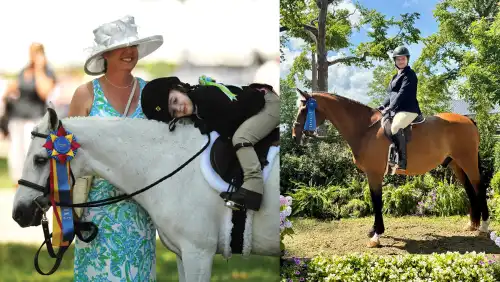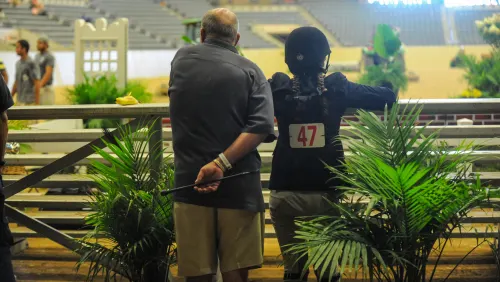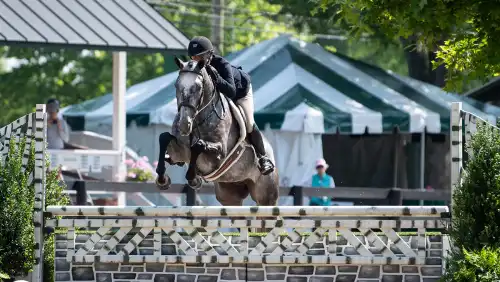Nostalgia reigned at the Hampton Classic in Bridgehampton, N.Y., where retiring executive directors Tony Hitchcock and Jean Lindgren got a formal farewell, as their friend, 1984 Olympic double gold medalist Joe Fargis, scored a resounding triumph in the grand prix.
The victory on Edgar in the $100,000 Prudential Douglas Elliman Real Estate Grand Prix, Sept. 4, was the first major grand prix win for Fargis, 57, in two years.
He achieved it with a determined performance and the advantage of going last in an eight-horse tiebreaker, a spot earned by virtue of his victory two days earlier in the $30,000 Sotheby’s Inter-national Realty grand prix qualifier, which drew 54 starters. No rider has ever won both the Friday class, which was also a World Cup qualifier, and the grand prix, in the same Classic. Until several years ago, that impressive double would have earned Fargis a $100,000 bonus, but Hitchcock said the show had to drop the promotion because insurance costs were too high.
The field of 30 included varying levels of horses and riders. Course designer Conrad Homfeld’s mission involved providing a challenge worthy of a $100,000 class while not overfacing anyone–and making sure that there was a big enough jump-off to thrill the crowd of 12,000.
“I consider the Hamptons to be a very difficult competition because there’s a lot of atmosphere there, the liverpools and the water,” said Olympic double medalist Chris Kappler, competing in the biggest class of his short partnership with his new mount, VDL Oranta.
Challenges included a triple combination near the end of the course, heading to the out-gate, where 14 competitors faulted. That was followed by an airy vertical at a liverpool, the last fence, that required a 45-degree turn from the triple. There was also a difficult line near the beginning of the course that involved a water jump six strides from a demanding vertical-to-oxer double combination.
“I was trying to be carefully restrained,” said Homfeld, who rode on the 1984 Olympic squad with Fargis and was not surprised that his former teammate won. “He is, after all, an individual gold medalist, and there are not that many of them walking around. He has his days.”
Kappler was first in the jump-off and didn’t push his mount because it was their first tie-breaker together. His time of 44.46 seconds was eminently beatable as the next combination, Candice King and Tarco, proved by coming home clean in 42.02 seconds. The knowledgeable crowd was waiting for the third starter, Margie Engle on her 2000 Olympic mount, Hidden Creek’s Perin, to set yet another new mark. But in her quest to do that, she took too sharp an angle to the third fence, where Perin hit the pillar. The jolt unseated Engle, whose foot was briefly caught in the stirrup as she fell.
The three starters after that–Ken Berkley on Carlos Boy, Aaron Vale with Artur (setting the fastest time of 39.61 seconds) and Jimmy Torano aboard Aguila–all had 4 faults.
Next-to-last was Anne Kursinski, the runner-up to Fargis in the qualifier with the swift Roxana. The odds were that Kursinski, who had her first competitive ride on the bay Hessen mare at the Classic the year before, was going to turn in a blistering trip. She did best King, but her clocking of 41.82 seconds left Fargis some room to work with. In retrospect, Kursinski said she didn’t take full advantage of her mare’s speed because she pulled back coming out of the corners.
The look on Fargis’ face was pure determination as he entered the ring for his shot at the $30,000 first prize. The oldest rider in the class pushed his 16-year-old Hano-verian, the oldest horse in the class, and their joint experience produced the winning result in a time of 41.69 seconds.
The self-effacing Fargis, who also won the grand prix in 1991 on Mill Pearl, didn’t reveal any master plan behind his victory, aside from having watched Kursinski go and observing her turns.
“You just try to do the best you can, and the best for me today was very good,” he said. “A lot of times it doesn’t work out, but you push and you turn and you keep going. I’m not sure there’s much strategy, except for really trying.”
Fargis also took a class earlier in the week with Diams III, earned the style award for his grand prix performance and wound up with the FEI open jumper championship. But even after a run like that, the silver-haired rider’s age makes some wonder whether he thinks about retirement.
“I always question myself about being too old, and then something like this will happen. I never expected something like this,” Fargis said. “I have no plans for retiring–or continuing. If God or the universe gives it to me, I’ll take it and love it.”
For Fargis, who lives part of the year in nearby Southampton, a Classic victory is extra special. “It’s fun to win out here. I have a lot of friends around to share the joy and all of it.”
ADVERTISEMENT
He is also a pillar of the Classic. “Joe Fargis has been a member of our board of directors for years, and that’s something we’re proud of,” said Hitchcock.
There were several tributes to Hitchcock and Lindgren during the show, including a plank on the first fence in the grand prix that bore the words: “Good Luck Tony and Jean.”
Though the couple will be staying on through March to help the new executive director, Shanette Barth, their last show was a milestone in their 30 years of association with the Classic, which they took from a local competition to one of the country’s best hunter/jumper fixtures.
New Faces And Names
Fargis may have dominated the grand prix action at the Hampton Classic, but on the hunter side it was all Scott Stewart. Stewart rode to the green conformation hunter tri-color on Granted and the regular conformation championship on Chopard. Stewart’s students also prevailed. Molly Ohrstrom repeated her triumphs of last year by claiming the championship in a section of adult amateur, 36-45, on her Practical.
And Alex Stathis, in her first Hampton Classic, took the small junior hunter, 15 and under, tricolor with her Davis Cup. “It was such a big win for me. I was very surprised. I was a little nervous, but I seem to do better under pressure,” Stathis said. “I felt so motivated when I went into the ring. I’ve been working really hard this summer, and it’s paying off.”
Stathis bought Davis, an 8-year-old Dutch Warmblood, from Stewart two years ago and then came to ride with him a year ago. “Scott has really helped me figure out how to ride Davis–what makes him happy and what he doesn’t like,” she said.
“What I really like about [Davis] is that he’s got a great rhythm and stays at an even pace. He’s very comfortable, and his jump is just unbelievable. I can really sit down on him and push him up to the bit,” she added.
That ride is very different from the one she has to give Truly, the large junior she’s leasing from Ohrstrom. “They both jump incredibly, but differently. Davis really powers off the ground, and Truly is more of a light touch,” said Stathis, who also earned Hampton Classic ribbons with Truly.
Maria Takacs is a veteran of showing at the Hampton Classic. But that was five years, two children, and a wedding ago. Then she was Maria La Reddola on Full Circle–now she’s Maria Takacs on Mombo, and she earned the amateur-owner hunter, 36 and over, tricolor. “I haven’t shown at the Hamptons in so long, but it was really fun, and such an exciting place to win,” she said.
After she retired Full Circle five years ago, Takacs took some time to concentrate on family. She now has a 21³2-year-old son, and a daughter born in March. She didn’t ride at all during her pregnancies, but she showed lightly in between the two children on an-other horse, Fiorello. “But I’ve definitely been out of the mix. I was a little rusty, and it for sure took a few months to get going again,” she said with a laugh.
She bought Mombo during her second pregnancy, without even trying him. Trainers Rolf and Jenn Bauersachs found the 9-year-old Westphalian for her. “I started riding again in June and then showed for the first time in July at Lake Placid [N.Y.]. The Hampton Classic was just my fourth show on Mombo!” she said.
“But he’s very amateur-friendly. After my children, I promised myself I wouldn’t have any more high-drama horses. Both of mine now are reliable and quiet. It was hard to be on the sidelines for so long, because I love to ride, but now I’m back,” Takacs said.
Moving Up To Win
Nikko Ritter had a great weekend, winning the $25,000 Calvin Klein Jumping Derby on Qroqant Z and placing second in the CK Equitation Championship. “This is a great show to win at, and I didn’t think it would go as well as it did, but I’m very happy,” Ritter said.
Ritter has only had the ride on Qroqant Z, a 10-year-old, Zangersheide mare, for two months. His mother, trainer Wendy Ritter-Peralta, found her in Argentina. “I’ve never had a horse that nice before. She was national champion there a couple of times, and she’s just awesome. To ride that quality of horse isn’t that hard,” he said.
Right after they met, Ritter and Qroqant Z went to the North American Young Riders Championships (Va.) and placed fifth individually. Ritter hopes to qualify for the BET/USEF Prix Des States competition at the Pennsylvania National in October but admits that she might get sold before then.
ADVERTISEMENT
Most of Ritter’s mounts have been sales horses coming through his mother’s Sea Breeze Farm in Geneva, Fla. But his catch ride for the CK Equitation Championship was a welcome change–an experienced competitor a student of his mother’s lent him.
Clover Count had seen it all in the CK class before, having carried riders to ribbons the last two years. “It was nice to basically know that he was going to be good,” said Ritter. “We had a rail in the first round that pulled my score down, but in the second round he jumped everything great.”
The CK class is one of the last in the country that runs over natural fences, including an open water, a grob, and a bank. “I like this class because it seems like equitation classes have gotten so generic. It’s nice to have a different challenge,” he said.
Those different challenges really changed the results in the second round, when the bank made its first appearance on course. Ritter moved up from sixth to second, and Jessica Speiser moved up from fourth to first.
“Coming back fourth, I didn’t think I had a shot to win, but a lot of the top people had problems at the bank, so I was very excited,” said Speiser. She scored an 84 in the first round, and topped it off with an 88 in the second for the blue.
Given all the natural obstacles on the course, Speiser chose to ride her junior jumper, Libidou, instead of her equitation horse. “I was hoping she wouldn’t be too jumpery, but she jumped around the first round great. Once I knew she was going to be fine, I relaxed and just rode,” she said.
Speiser, of Armonk, N.Y., is a long-time veteran of the horse show circuit, having come up through the pony and junior ranks. She rides with Andre Dignelli and the team at Heritage Farm. “At home, Andre sets up all kinds of crazy courses. One thing about him is that I always feel very prepared going to a show,” said Speiser.
Now 18, Speiser is taking a year off between high school and attending New York University to concentrate on her riding, and she’s aiming for the fall equitation finals in her last year as a junior.
Working Hard For The Win
After Jodi Czaplick had won the last over-fences class and the under saddle class in the amateur-owner hunter, 18-35, division, she asked her trainer if perhaps she might have enough points to be reserve champion. “But then, I head them say ‘Jodi and Untold stand by for champion?’ We were jumping up and down with joy. I was very excited,” she said.
Czaplick, of East Quogue, N.Y., has been showing at the Hampton Classic since she was champion in the short stirrup in 1997. “The Hampton Classic is by far my favorite horse show of the whole year,” she said.
As a local, Czaplick ships her horse in each day to show. That adds to her busy summer schedule, braiding for four barns. “By the Hampton Classic, I am totally wiped out from braiding all night and then getting one hour of sleep before I have to wake up at 3 a.m. to get my horse ready to show. It’s a nightmare by the end of the summer, but it’s worth it for sure,” she said.
Czaplick keeps her horses at home, and her mother takes care of them. “And Untold is the king of the barn. He has a stall at the end of the barn that’s 30′ by 20′, ” she said with a laugh. They usually show locally, and Czalick made her first trip to Florida this winter.
Untold, or “Bart,” caught Czaplick’s eye three years ago at a local indoor show, where he was showing under Jenny Fischer. “I fell in love with him. My mom said he was way out of our price range. But I rode him that day, and I rode him great,” Czaplick recalled. But Bart’s price tag kept him out of reach.
A few months later, however, Czaplick’s horse got injured, and she thought of Bart again. This time, the deal was done, and he joined her barn just two weeks before the 2003 Hampton Classic, where they took the children’s hunter reserve championship.
“I’m a big Thoroughbred lover, and when I saw him, he was just what I like,” Czaplick said of Bart (Unfold–North Eden), who was bred by Nancy Baginski and is now 9. “He’s an exceptional mover. He was sometimes hard, because he was young. Sometimes he’d be fresh, or spooky, but when I brought him to Ocala this winter, he totally just mellowed out. Now, I can not ride him for a week, take him to a horse show, and he’s the same horse.”
This is Czaplick’s first year as an amateur, and while she sometimes rides with trainer Keith Powell of Ocala, Fla., she does a lot of the work on her own. “When I turned amateur, I figured I could do it. My mom helps me and sets jumps, and Keith meets me at the big shows,” she said.














